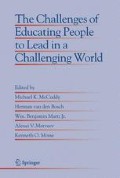Abstract
In this paper we discuss the potential implications of commonly used student ratings of teacher performance on faculty members’ willingness to pursue innovative educational practices. Our fundamental contention is that student ratings of teaching are potentially detrimental to innovative education. In exploring this fundamental contention, we first examine the inherent evaluation and developmental challenges associated with student ratings. Next, we discuss the common uses, misuses, and abuses of student ratings from both an evaluative perspective and a developmental perspective. We then propose an alternative approach — one based on behaviorally anchored rating scales — for utilizing student ratings. This proposed approach can potentially limit the misuses and abuses of student ratings, and can promote their viability as useful and accepted tools for both evaluative and developmental purposes, especially for the latter. Finally, we conclude the paper with a statement of our beliefs regarding the dangers associated with adhering to a student-as-customer mode of teacher ratings — dangers which can discourage innovative educational efforts and pervert the educational process as well as undermine students’ acquisition of the competencies they will need to function effectively in modern society.
Access this chapter
Tax calculation will be finalised at checkout
Purchases are for personal use only
Preview
Unable to display preview. Download preview PDF.
References
Bures, A. L., De Ridder, J. J., & Tong, H. M. (1990). An empirical study of accounting faculty evaluation systems. The Accounting Educators’ Journal, 68–76.
Cashin, W. E. (1983). Concerns about using student ratings in community colleges. New Directions for Community Colleges, 11, 1, 57–65.
Centra, J. A. (1993). Reflective Faculty Evaluation. San Francisco: Jossey-Bass.
Chen, Y., & Hoshower, L. B. (2003). Student evaluation of teaching effectiveness: An assessment of student perception and motivation. Assessment & Evaluation in Higher Education, 28, 1, 71–88.
Christ, L. F., Christ, M. Y., Graham, A. S., McCuddy, M. K., & Pirie, W. L. (2004). Using team learning in the classroom: Experiences and lessons. In R. Ottewill, L. Borredon, L. Falque, B. Macfarlane, & A. Wall (Eds.), Educational Innovation in Economics and Business VIII: Pedagogy, Technology and Innovation (pp. 129–146). Dordrecht: Kluwer Academic Publishers.
Hobson, S. M., & Talbot, D. M. (2001). Understanding student evaluations. College Teaching, 49, 1, 26–31.
Hoppes, S., & Chesbro, S. (2003). Elements of instruction in allied health: Do Faculty and students value the same things? Journal of Allied Health, 32, 3, 167–172.
Kember, D. (2000). Action Learning and Action Research: Improving the Quality of Teaching and Learning. London: Kogan Page.
Kerr, S. (1975). On the folly of rewarding A, while hoping for B. Academy of Management Journal, 18, 769–783.
Kolitch, E., & Dean, A. V. (1999). Student ratings of instruction in the USA: Hidden assumptions and missing conceptions about ’good’ teaching. Studies in Higher Education, 24, 1, 27–42.
Kolstoe, O. P. (1975). College Professoring: Or Through Academia with Gun and Camera. Carbondale: Southern Illinois University Press.
Lowman, J. (1984). Mastering the Techniques of Teaching. San Francisco: Jossey-Bass.
Martin, J. R. (1998). Evaluating faculty based on student opinions: Problems, implications and recommendations from Deming’s theory of management perspective. Issues in Accounting Education, 13, 4, 1079–1094.
McKeachie, W. J. (1997). Student ratings: The validity of use. American Psychologist, 52, 1218–1225.
Newton, J. D. (1988). Using student evaluation of teaching in administrative control: The validity problem. Journal of Accounting Education, 6, 1–14.
Palmer, P. J. (1998). The Courage to Teach. San Francisco: Jossey-Bass.
Penny, A. R. (2003). Changing the agenda for research into students’ views about university teaching: Four shortcomings of SRT research, Teaching in Higher Education, 8, 3, 399–411.
Reckers, M. P. (1996). Know thy customer. Journal of Accounting Education, 179–185.
Saroyan, A., & Amundsen, C. (2001). Evaluating university teaching: Time to take stock. Assessment & Evaluation in Higher Education, 26, 4, 341–353.
Schneider, B., Hanges, P. J., Goldstein, H. W., & Braverman, E. P. (1994). Do customer service perceptions generalize? The case of student and chair ratings of faculty effectiveness. Journal of Applied Psychology, 79, 685–690.
Seldin, P. (1993). The use and abuse of student evaluation of professors. The Chronicle of Higher Education, 40, 1, A40.
Simpson, P. M., & Siguaw, J. A. (2000). Student evaluations of teaching: An exploratory study of the faculty response. Journal of Marketing Education, 22, 3, 199–213.
Tamblyn, P. (2000). Qualities of success: Lessons from a teaching career. Education Canada, 40, 1, 16–19.
Wiesenfeld, K. (1996). Making the grade. Newsweek, 16.
Wilson, R. (1998). New research casts doubt on value of student evaluations. Chronicle of Higher Education, 44, 19, A12+.
Wright, P., Whittenton, R., & Whittenberg, G. E. (1984). Student ratings of teaching effectiveness: What the research reveals. Journal of Accounting Education, 2, 5–30.
Zarra III, E. J. (2003). Taking it to the next level: Components of excellent secondary educators. Paper presented at the Annual Meeting of the American Association of Colleges for Teacher Education, New Orleans.
Author information
Authors and Affiliations
Editor information
Editors and Affiliations
Rights and permissions
Copyright information
© 2007 Springer
About this chapter
Cite this chapter
McCuddy, M.K., Pirie, W.L. (2007). WILLINGNESS TO INNOVATE. In: McCuddy, M.K., van den Bosch, H., Martz, W.B., Matveev, A.V., Morse, K.O. (eds) The Challenges of Educating People to Lead in a Challenging World. Educational Innovation in Economics and Business, vol 10. Springer, Dordrecht. https://doi.org/10.1007/978-1-4020-5612-3_8
Download citation
DOI: https://doi.org/10.1007/978-1-4020-5612-3_8
Publisher Name: Springer, Dordrecht
Print ISBN: 978-1-4020-5611-6
Online ISBN: 978-1-4020-5612-3
eBook Packages: Business and EconomicsBusiness and Management (R0)

